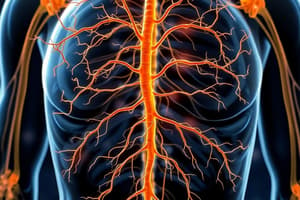Podcast
Questions and Answers
From which segments of the spinal cord does the sympathetic outflow come from?
From which segments of the spinal cord does the sympathetic outflow come from?
- All lumbar and sacral segments
- All thoracic and lower three lumbar segments
- All thoracic and upper three lumber segments (correct)
- Cervical and upper thoracic segments
Which of the following organs is under the control of both sympathetic and parasympathetic systems?
Which of the following organs is under the control of both sympathetic and parasympathetic systems?
- Heart
- G.I.T.
- Tracheobronchial tree
- Urinary bladder (correct)
What is the effect of adrenaline on β2 receptors?
What is the effect of adrenaline on β2 receptors?
- Dilates tracheobronchial tree (correct)
- Constricts tracheobronchial tree
- Increases heart rate
- Increases blood pressure
What is the therapeutic use of adrenaline in treating glaucoma?
What is the therapeutic use of adrenaline in treating glaucoma?
What is the physiological antidote of histamine?
What is the physiological antidote of histamine?
What is the cranial division of the parasympathetic nervous system responsible for?
What is the cranial division of the parasympathetic nervous system responsible for?
What is the primary function of the autonomic nervous system?
What is the primary function of the autonomic nervous system?
Which of the following organs is NOT under parasympathetic tone?
Which of the following organs is NOT under parasympathetic tone?
What is the mechanism by which adrenaline prolongs the effect of local anesthetics?
What is the mechanism by which adrenaline prolongs the effect of local anesthetics?
What is the opposing effect of the sympathetic and parasympathetic nervous systems on certain organs?
What is the opposing effect of the sympathetic and parasympathetic nervous systems on certain organs?
What is the therapeutic use of adrenaline in treating bronchial asthma?
What is the therapeutic use of adrenaline in treating bronchial asthma?
What is the effect of adrenaline on the iris?
What is the effect of adrenaline on the iris?
Flashcards are hidden until you start studying
Study Notes
Autonomic Nervous System (A.N.S)
- A.N.S is divided into sympathetic and parasympathetic nervous systems.
- Sympathetic outflow comes from all thoracic and upper three lumber segments of the spinal cord.
- Parasympathetic outflow comes from:
- Cranial division: III, VI, and X cranial nerves.
- Sacral division: 2nd and 3rd sacral segments of the spinal cord.
Organs Under A.N.S Control
- Organs under parasympathetic tone: Heart, G.I.T., urinary tract, and tracheobronchial tree.
- Organs under sympathetic tone: Blood vessels.
- Organs under both sympathetic and parasympathetic systems: Iris and urinary bladder.
Function of A.N.S
- Regulates involuntary functions of the body, such as digestion, circulation, body temperature, and sweat.
- Functions of sympathetic and parasympathetic systems are usually opposing each other.
- The effect on a certain organ is the sum of both effects.
Drugs Acting on Sympathetic N.S: Adrenaline
- Adrenaline is a potent stimulant of both α and β receptors.
- Therapeutic uses:
- Local:
- To stop local bleeding (e.g., epistaxis).
- Added to local anesthetics to prolong their effect.
- Nasal decongestant in common cold.
- On eye to treat glaucoma.
- Systemic:
- Dilates tracheobronchial tree in cases of bronchial asthma.
- Cardiotonic (can be given intracardiac in cases of heart arrest).
- Treats allergy and anaphylactic shock due to its physiologic antidote effect on histamine.
Autonomic Nervous System (A.N.S)
- A.N.S is divided into sympathetic and parasympathetic nervous systems.
- Sympathetic outflow comes from all thoracic and upper three lumber segments of the spinal cord.
- Parasympathetic outflow comes from:
- Cranial division: III, VI, and X cranial nerves.
- Sacral division: 2nd and 3rd sacral segments of the spinal cord.
Organs Under A.N.S Control
- Organs under parasympathetic tone: Heart, G.I.T., urinary tract, and tracheobronchial tree.
- Organs under sympathetic tone: Blood vessels.
- Organs under both sympathetic and parasympathetic systems: Iris and urinary bladder.
Function of A.N.S
- Regulates involuntary functions of the body, such as digestion, circulation, body temperature, and sweat.
- Functions of sympathetic and parasympathetic systems are usually opposing each other.
- The effect on a certain organ is the sum of both effects.
Drugs Acting on Sympathetic N.S: Adrenaline
- Adrenaline is a potent stimulant of both α and β receptors.
- Therapeutic uses:
- Local:
- To stop local bleeding (e.g., epistaxis).
- Added to local anesthetics to prolong their effect.
- Nasal decongestant in common cold.
- On eye to treat glaucoma.
- Systemic:
- Dilates tracheobronchial tree in cases of bronchial asthma.
- Cardiotonic (can be given intracardiac in cases of heart arrest).
- Treats allergy and anaphylactic shock due to its physiologic antidote effect on histamine.
Studying That Suits You
Use AI to generate personalized quizzes and flashcards to suit your learning preferences.




